Before the foundation of the Ferrocarrils de la Generalitat Valenciana (FGV), the narrow-gauge rail network in Valencia consisted of a classic suburban network, which had a great deal of importance in the metropolitan area but very little influence in strictly urban traffic movements.
1988
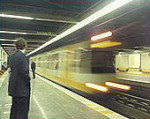 In October 1988, the first underground section of the network, which was 7 kilometres long, was opened and connected the suburban lines of Llíria, Bétera and Rafelbunyol to the north of the city and with the Villanueva de Castellón line to the south.
In October 1988, the first underground section of the network, which was 7 kilometres long, was opened and connected the suburban lines of Llíria, Bétera and Rafelbunyol to the north of the city and with the Villanueva de Castellón line to the south.
1994
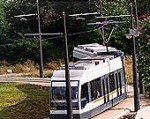 In May 1994 the first section of the Line 4 Tram line went into operation. Through this project, Valencia became a pioneer in Spain in reintroducing this form of transport. The first section of Line 4 covered 9.7 kilometres and had 21 stations. Its route, following to a great extent the old Ademuz ?Grao line, made it possible to connect the Metro system with high-demand areas such as the Polytechnic University,the new Literary University of Valencia Campus and Malvarrosa Beach.
In May 1994 the first section of the Line 4 Tram line went into operation. Through this project, Valencia became a pioneer in Spain in reintroducing this form of transport. The first section of Line 4 covered 9.7 kilometres and had 21 stations. Its route, following to a great extent the old Ademuz ?Grao line, made it possible to connect the Metro system with high-demand areas such as the Polytechnic University,the new Literary University of Valencia Campus and Malvarrosa Beach.
1995
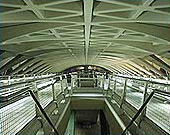 In May 1995, the new underground section of Line 3 was opened to the public, running from Palmaret station to Alameda. Four new stations were built on this 2.9 kilometre section.
In May 1995, the new underground section of Line 3 was opened to the public, running from Palmaret station to Alameda. Four new stations were built on this 2.9 kilometre section.
1998
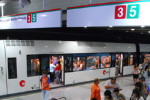
In September 1998 Line 3 was extended from the Alameda station to the Av. del Cid. The intermediate stations, Colón, Xàtiva and À. Guimerà – already had stations along Line 1 on another level. Simultaneously the branch between Colón and Jesús was put into service. This was a key milestone in the evolution of Metrovalencia and in the development of public transport in Valencia and its metropolitan area.
The two new stretches covered several of the most commuted urban zones and provided articulation for different metro and tram lines and also connected to RENFE’s Central Station in Valencia. This expansion caused a spectacular increase in passengers throughout the network and provided changeovers at À. Guimerà.
At the same, metro lines 1 and 2 merged into one line (Line 1) that divides at the Empalme station towards either Bétera or Llíria.
1999
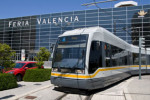
In March 1999 Line 4 was extended to TVV. This new stretch has 5 stops and services important high demand areas like the clinic, Ambulatorio de la Granja or the Burjassot University Campus and TVV.
In May 1999 Line 3 was completed. The extension to Mislata-Almassil provides this populated area with a comfortable and efficient alternative connection to Valencia’s city centre. This last stretch of Line 3 is 2,198 kilometres long and has 3 stations (Nou d’Octubre, Mislata and Mislata-Almassil).
In September 1999 the branch to Feria Valencia on Line 4 was put into service to facilitate access to different events for exhibitors, professionals and the general public. Feria Valencia, an institution with a very important role in Valencian economy fulfilled its aspiration.
2001
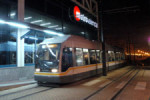 In March 2001 the new Empalme station is inaugurated and becomes an important intermodal hub for Valencia and its metropolitan area. The new station connects to metro line 1 and tramline 4 and provides changeovers with EMT buses and MetroBús.
In March 2001 the new Empalme station is inaugurated and becomes an important intermodal hub for Valencia and its metropolitan area. The new station connects to metro line 1 and tramline 4 and provides changeovers with EMT buses and MetroBús.
2003
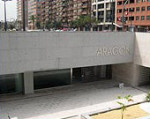 In April 2003 the first stretch of Line 5 starts offering service. In the future it would provide a link between the Maritime Façade in Valencia (Balcón al Mar) and the Manises Airport. It has three new stations (Aragón, Amistat and Ayora) and is 2,300 kilometres long.
In April 2003 the first stretch of Line 5 starts offering service. In the future it would provide a link between the Maritime Façade in Valencia (Balcón al Mar) and the Manises Airport. It has three new stations (Aragón, Amistat and Ayora) and is 2,300 kilometres long.
2004
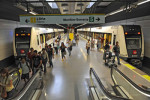 In September 2004 the underground branch to the municipality of Torrent and the old Torrent Avinguda station is inaugurated. It is situated on Avinguda del País Valencia, an expanding area in the city and it notably improves communication between Torrent and the city of Valencia and its metropolitan area.
In September 2004 the underground branch to the municipality of Torrent and the old Torrent Avinguda station is inaugurated. It is situated on Avinguda del País Valencia, an expanding area in the city and it notably improves communication between Torrent and the city of Valencia and its metropolitan area.
2005
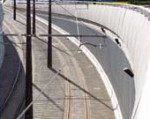
In September 2005 the Line 4 extension to Mas del Rosari starts service. The stretch is almost 3 kilometres long and has five stops: TVV, Santa Gemma, Tomás y Valiente, La Coma and Mas del Rosari.
With this route, that covers the municipalities of Burjassot and Paterna, the T-4 services the University of Valencia’s extended Campus as well as a large area undergoing urban expansion.
In October the new Bailén station on metro line 5 starts offering service. It is situated next to the Grandes Vías tunnel, between the Colón and Jesús stations. The Bailén station stop will become an intermodal connection hub for the Metrovalencia network with the future Parque Central station where transport services such as AVE, local and regional trains and Renfe Main Lines will converge.
In December 2005 the extended branch on Line 4 to Lloma Llarga-Terramelar is inaugurated. This branch has one stop with the same name and services Terramelar and Valterna in the municipality of Paterna.
2007

That same month, at the other end of Line 5, the extension between Mislata-Almassil and the Manises Airport is opened. The new stretch has 6 stations (Faitanar, Quart de Poblet, Salt de l´Aigua, Manises, Rosas and Aeroport). Unfortunately, only 5 could be opened to the public that year due to urban planning issues, not connected to FGV, concerning the Faitanar station. They were resolved the following year and the station was inaugurated in 2008.
With these two new stretches the configuration of Line 5 culminates in an important transport hub that connects the three large mobility generating centres in the area: The Port, Airport and Renfe Central station.
In October the first phase of the Orbital Tram (Line L-6) starts offering service. It is 9,2 kilometres long and covers the route between the Tossal del Rei Plaza and the Marítim-Serrería station.
This first phase of the T-6 travels through the Torrefiel and Orriols neighbourhoods along a new 2,45 kilometres long tramway stretch until it connects with Line 4 on Almazora Street. From here on it shares the platform with Line 4 until the loop at Dr. Lluch, where it continues onto the Line 5 tramway stretch and comes to an end at the Maritím-Serrería station.
2010
 On 12 December 2010 the President of the Generalitat opened two underground stations in the municipality Metrovalencia Alboraya. With this opening is serving a historical demand of the town bordering Valencia. That day, the surface stations and Alboraia Palmaret stopped working and were replaced by new-Palmaret Alboraya estacionessubterráneas and Alboraya-Peris Aragó.
On 12 December 2010 the President of the Generalitat opened two underground stations in the municipality Metrovalencia Alboraya. With this opening is serving a historical demand of the town bordering Valencia. That day, the surface stations and Alboraia Palmaret stopped working and were replaced by new-Palmaret Alboraya estacionessubterráneas and Alboraya-Peris Aragó.
The construction works of new stations began in March 2006 and had a budget of 70 million euros, including the work of urban renewal. The work involved the burial of the railway line by a trace, run on double track in its entirety, which started in the Depot Machado Brothers and ended with the current ground at a point near the bridge over the ravine Carraixet next to the municipal boundary between Alboraya and Almàssera.
The action led to the elimination of three level crossings and allowed to recover Alboraya 15,000 square meters of area for open spaces and pedestrian.The new underground stations have the most advanced equipment accessibility. In addition to escalators and elevators, new stations are equipped with special platforms for access to the units in wheelchairs, soundtracks to facilitate the transit of blind and vision impaired, to facilitate communication devices for people hearing impaired and special areas of assisted rescue.
2011
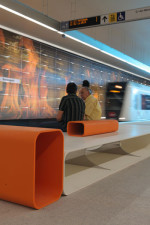
On the 15th of May the new Metrovalencia Line 1 underground stretch through Benimámet starts offering service. This new route has two underground stations at Benimàmet and Les Carolines-Fira, which substitute the previous overland stations.
The total length of the new route is 1,5 kilometres of which 1,1 kilometres is underground. It starts near the Cantereria station where trains descend into the tunnel and come out to the surface after passing the new underground station, Les Carolines-Fira.
This railway tunnelling allowed for the elimination of three level crossings, urban barriers and improved transport for Benimàmet.
This new service notably improves railway service since it reduces travel time and increases circulation security in the area.
2012

On the 6th of February the new entrance building to the Safranar station on Metrovalencia Line 1 opened its doors to offer access to people with reduced mobility. This meant that all of the underground stations on the network were accessible. The budget for the construction of a new access building to the Safranar station was 2,97 million euros.
The accessibility issue at Safranar was resolved by constructing a new access building at the extreme north east of the station where ticket vending and validation is situated. On the other side of the validating line, there is access to stairs, mechanical stairs and a lift that connects the building to an underground lobby leading to the different platforms through paths, stairs and lifts.
The floors in the new station are marked with different textured stripes and painted in different colours to signal the different routes for the blind or vision impaired.
2015
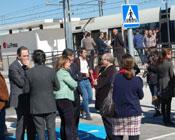 The extension of the Valencia Metro to Riba-roja de Túria was launched on the 6th of March, coinciding with the restructuring of the Metrovalencia network and the nomenclature of the lines, which establishes the Alboraya Peris Aragó to Riba-roja del Turia route as Line 9.
The extension of the Valencia Metro to Riba-roja de Túria was launched on the 6th of March, coinciding with the restructuring of the Metrovalencia network and the nomenclature of the lines, which establishes the Alboraya Peris Aragó to Riba-roja del Turia route as Line 9.
From the Rosas station, the route journeys through the municipal districts of Manises and Riba-roja. It is 9.467 metres long, 640 metres are underground, 311 metres are in trenches and 8.516 metres are ground level.
It has four new stops; La Cova, La Presa, Masía de Traver and Riba-roja de Túria. The double track ends at the first of these stops and a single track continues; La Presa and Masía de Traver coincide with the old halts that existed on commuter lines operated by Renfe and the Riba-roja de Túria stop is the end of the stretch.
2022
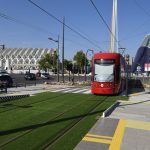 Line 10 (Alacant-Natzaret) was opened on 17th May with a length of 5,035.55 metres (2,222.40 underground and 2,813.15 metres above ground), 8 stations (3 underground: Alacant, Russafa and Amado Granell-Montolivet; and 5 above ground: Quatre Carreres, Ciutat Arts i Ciències-Justícia, Oceanogràfic, Moreres, and Natzaret) and runs through the east side of the city of Valencia.
Line 10 (Alacant-Natzaret) was opened on 17th May with a length of 5,035.55 metres (2,222.40 underground and 2,813.15 metres above ground), 8 stations (3 underground: Alacant, Russafa and Amado Granell-Montolivet; and 5 above ground: Quatre Carreres, Ciutat Arts i Ciències-Justícia, Oceanogràfic, Moreres, and Natzaret) and runs through the east side of the city of Valencia.
Its tramway route, therefore, allows to link the centre of the city of Valencia with one of the main tourist assets of the city, the Ciutat de las Arts i les Ciències, and with other areas that involve a great demand for mobility on a daily basis, such as the City of Justice, the current and future stadium of Valencia Basket, and other sports and commercial areas. In addition, many neighbourhoods of the city such as Russafa, Monteolivete, Na Rovella, Quatre Carreres, Moreres and the Natzaret neighborhood will have high-capacity public transport for the first time.


